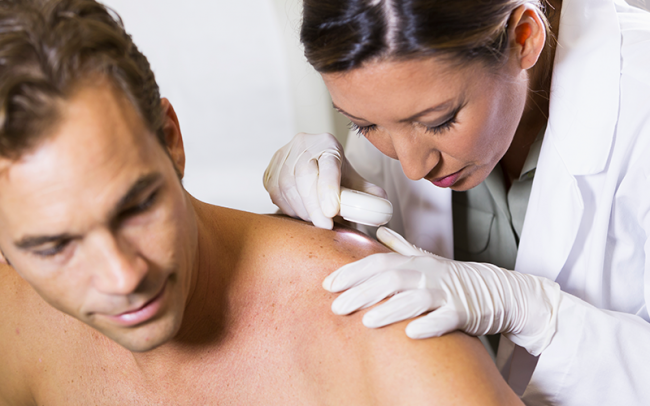Skin cancer is the most common form of cancer, with some 3.5 million cases diagnosed each year. Most skin cancer falls into one of three categories: basal cell carcinoma, squamous cell carcinoma or melanoma.
With skin cancer, the key is catching it early and receiving treatment before the cancer spreads to surrounding tissue. Once you have been diagnosed, there are many different skin cancer treatments, each with different side effects and degrees of effectiveness.
Which treatment is right for you? That largely depends on what type of skin cancer you have. Different types of cancers respond better to different treatments, which can range from topical medications to minor surgery.
Types of Skin Cancer
Basal cell carcinoma, which typically begins as a small, shiny bump on the face, is the most common type of skin cancer. Almost a million new cases of basal cell carcinoma are diagnosed in the U.S. each year, and up to 30% of Caucasians may develop this type of skin cancer during their lifetime.
Squamous cell carcinoma generally shows up as a firm, red nodule but may also appear as a flat sore or a raised area on an old scar or ulcer. It can aggressively spread to other parts of the body.
Melanoma — the deadliest form of skin cancer — can begin as a sore that doesn’t heal or a mole with an irregular border. This form of cancer can spread very quickly and become life-threatening if it isn’t diagnosed and treated early. Though melanoma accounts for only 4% of all skin cancer cases, it causes almost 79% of skin cancer deaths.
“Cancer is considered to be low risk when the affected cells are clustered together and is almost always curable when it is detected and treated early,” says Dr. Deborah Ohlhausen of U.S. Dermatology Partners Shoal Creek in Liberty, Missouri. “It becomes a higher risk and more difficult to treat when cells invade surrounding tissue.”
Here are some of the pros and cons of the most common skin cancer treatment options:
Mohs Micrographic Surgery
The most effective treatment of squamous cell carcinoma and basal cell carcinoma is the Mohs micrographic surgical technique. This revolutionary procedure enables your dermatologist to remove all of the visible cancer, as well as a small amount of surrounding tissue, under microscopic control.
Pros: This procedure is very effective. It results in minimal damage to the surrounding skin and the smallest possible wound.
Cons: Mohs Surgery is not effective for melanoma skin cancers. Some patients experience bleeding from the wound, minor pain, and tenderness around the surgical site and infection. It is possible to experience numbness around the surgical area if a nerve is severed during the procedure.
Cryosurgery (Cryotherapy)
Cryosurgery is a simple, non-invasive procedure that uses liquid nitrogen to freeze and destroy growths on the skin. Cryosurgery can also be used to treat pre-cancerous skin lesions or certain types of skin cancer that are still localized and haven’t spread to other parts of the body.
During cryosurgery, liquid nitrogen is applied directly to the skin lesions with a cotton swab, which allows the doctor to target damaged skin cells. The tissue is quickly frozen then slowly thaws, destroying the cancer at the cellular level.
Pros: This minimally invasive procedure is simple, affordable and has a very low risk of infection.
Cons: The treatment causes some pain. The affected area may blister and scab over but typically heals within three to six weeks.
Curettage
Curettage, a common treatment for basal cell and squamous cell cancers, removes skin cancer by scraping the area with a sharp loop-edge instrument called a curette. An electrocautery needle is then used to destroy any remaining cancer cells. The process can be repeated multiple times until all cancer cells have been destroyed.
Pros: Curettage is an effective and relatively inexpensive treatment for small, superficial basal and squamous cell carcinomas with well-defined borders.
Cons: Though the wound typically heals without sutures, there is some risk of scarring.
Surgical Excision
During surgical excision, skin cancer is removed with a scalpel under a local anesthetic. In addition to the cancer itself, some surrounding normal skin is also removed to ensure that the cancer has been completely removed.
Melanoma tumors must be removed surgically before they spread to other parts of the body. If caught early, a dermatologist can typically surgically remove melanoma in the office. Melanoma that has spread may require a general surgeon or oncologist and more extensive surgery, radiation or even chemotherapy.
Pros: The success rate of surgical excision is very high.
Cons: After surgery, the wound is repaired with sutures, which carries a risk of scarring in some patients.
Before recommending a skin cancer treatment for you, your dermatologist will consider many factors including the type of skin cancer you have, your tolerance for surgery and whether the cancerous cells have spread to surrounding tissue.
Looking to Visit a Dermatologist for Skin Cancer Treatment?
To learn more about these and other skin cancer treatment options, make an appointment with one of our board-certified dermatologists today. We have multiple locations throughout the country, so fill out our simple online form to get in touch with us. One of our local team members will reach out to you shortly to answer your questions or schedule an appointment for you to visit us soon.
Find a location near me
or

